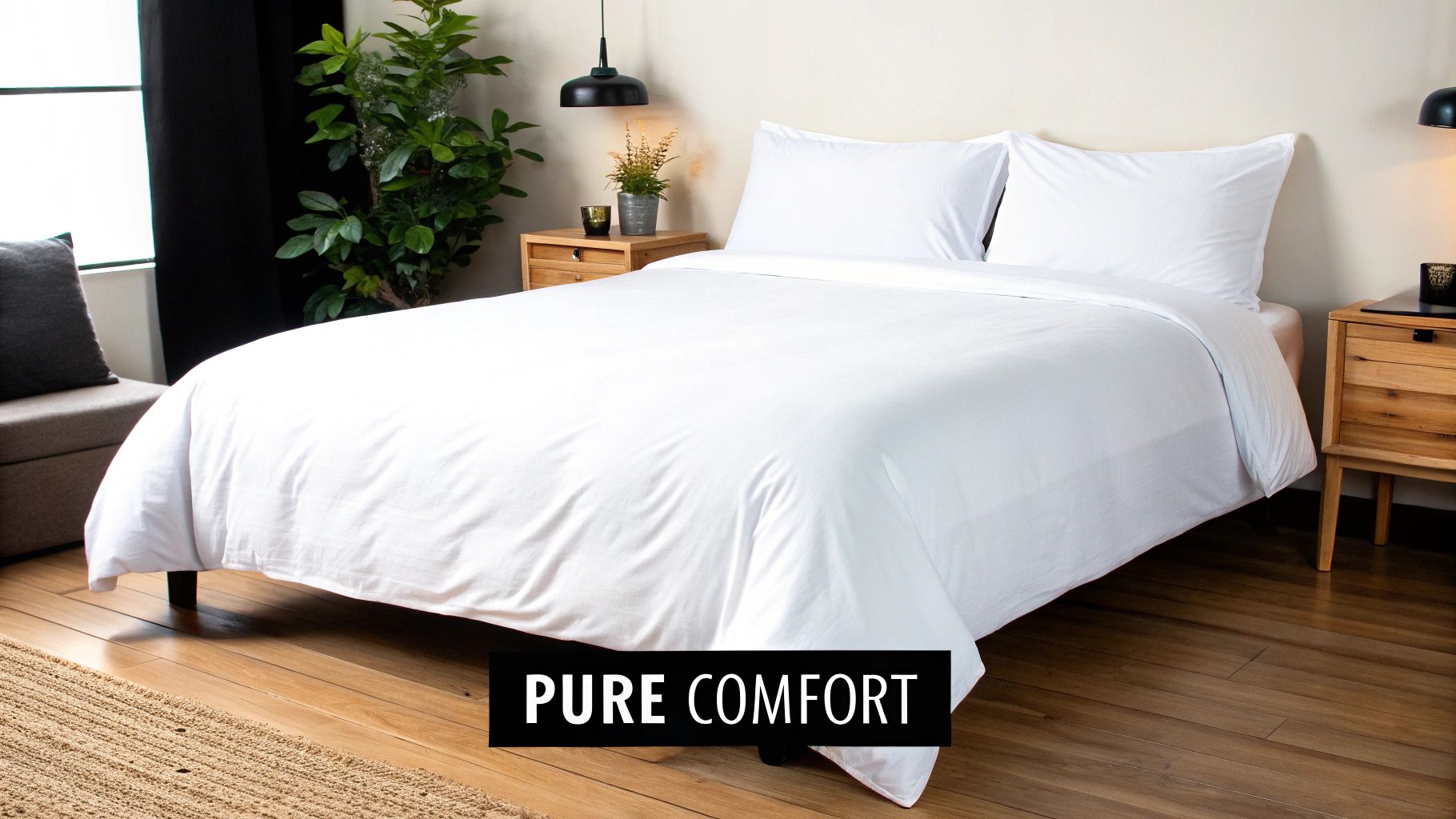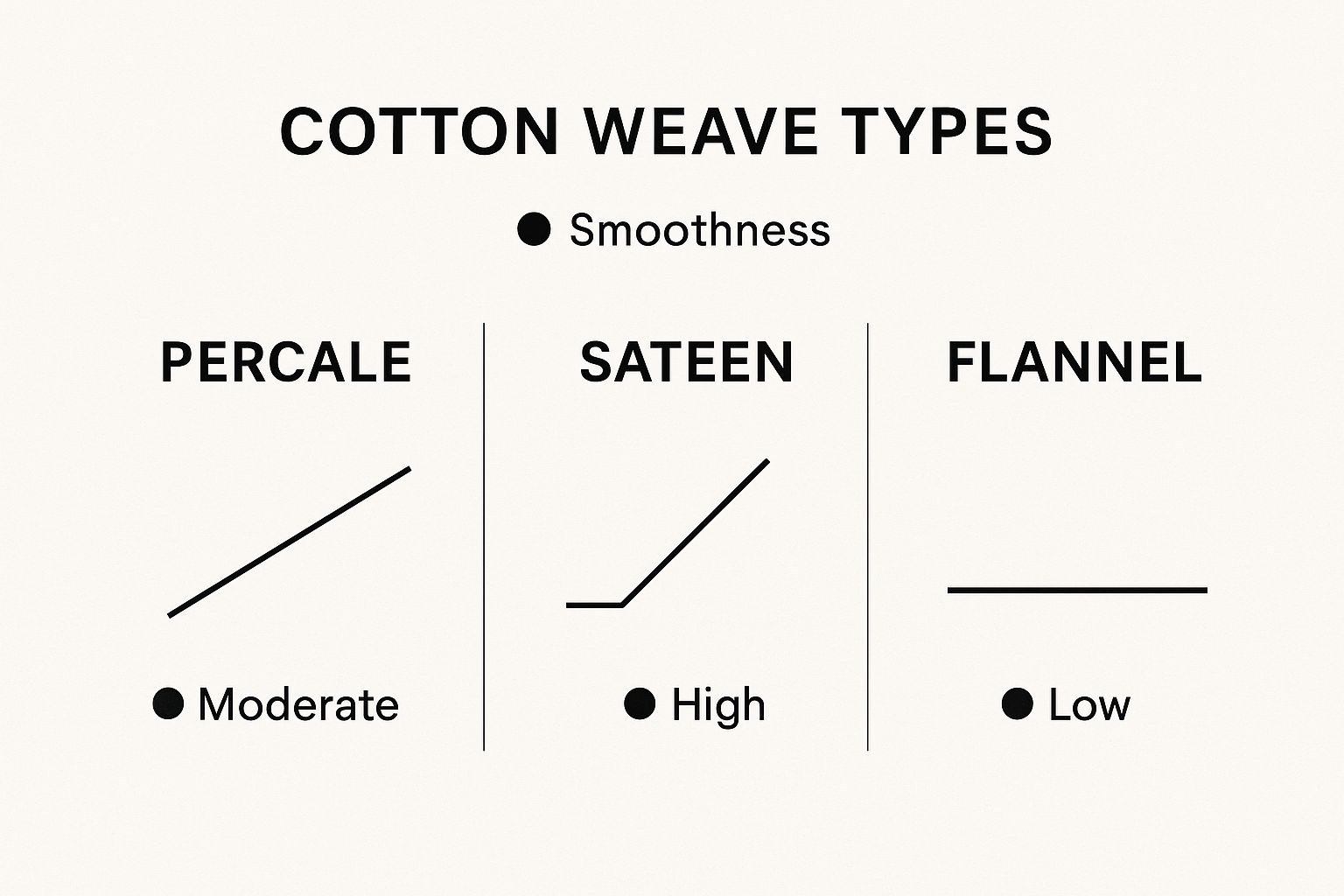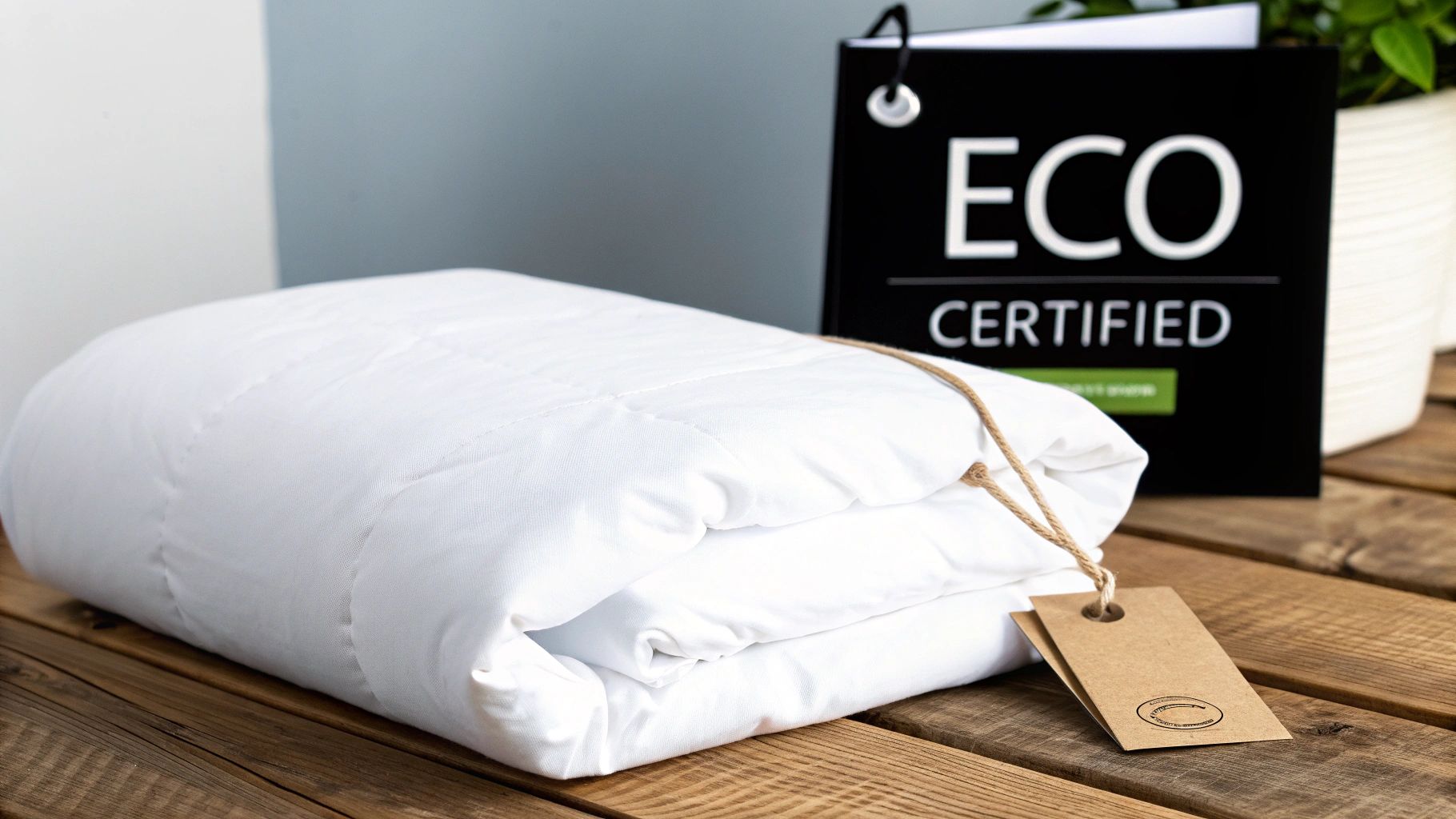Choosing the perfect cotton duvet cover in NZ is about so much more than just picking a nice pattern. It’s a genuine investment in your sleep, and a chance to find something that perfectly suits our unique Kiwi climate. A great duvet cover can turn your bed from just a piece of furniture into a personal sanctuary, but let's be honest—getting bogged down in talk of weaves and thread counts can be a bit much.
Your Guide to Lasting Bedroom Comfort

Think about it: your duvet cover is the biggest piece of fabric in your bedroom. It sets the tone for the entire room's style and, more importantly, it's the first thing you feel when you slide into bed. Here in New Zealand, where a single day can feel like it has four seasons, having the right material is everything. You need something that breathes on a humid summer night but still feels cosy when the winter chill sets in.
This guide is here to cut through the noise. We'll get past the marketing hype and focus on what actually makes a duvet cover feel amazing. We're going to break down how the weave changes the feel and breathability of the fabric, explain why a higher thread count doesn't automatically mean better quality, and help you find a style that captures that relaxed, modern Kiwi vibe.
Building Your Sleep Sanctuary
The ultimate goal is to create a space that helps you switch off and get truly restorative sleep. Your bedding is the heart of this, but it’s not the only piece of the puzzle.
A truly comfortable and effective sleep sanctuary is built on layers. It starts with the tactile pleasure of quality bedding and extends to the light, sound, and temperature of the room itself. Each component works together to signal to your body that it’s time to rest.
While the feel of a beautiful duvet cover is essential, lasting comfort also comes from optimizing your overall sleep environment. When you get all these elements working together, your bedroom transforms into a place you can’t wait to retreat to.
Consider this your roadmap to making a choice you'll be happy with for years to come. By the time you're done, you'll know exactly what to look for in a durable, comfortable, and beautiful cotton duvet cover. Let's get started on turning your bedroom into the ultimate retreat.
How Cotton Weaves Shape Your Sleep Experience
When you’re choosing a cotton duvet cover nz, the single most important factor determining how it feels is the weave. This is simply the pattern used to interlace the cotton threads, and it completely transforms the final fabric. Each style of weave creates a totally different texture, weight, and even appearance, which directly shapes how comfortable you feel and how well you sleep.
Think of it like baking. You can start with the same basic ingredients—flour, sugar, eggs—but your method changes everything. A light, airy sponge cake is a world away from a dense, rich mud cake. The same idea applies to cotton; the way the threads are woven defines the end result.
Getting your head around these differences means you can choose a duvet cover for the feeling you want, not just the look. Are you after that cool, crisp luxury hotel vibe, or something silky and warm for a cosy winter retreat? The weave is what gets you there.
Percale: The Crisp and Cool Classic
If you love that feeling of slipping into a freshly made hotel bed, you’re almost certainly a fan of percale. It’s made with a simple one-thread-over, one-thread-under pattern, a bit like a classic basket weave. This tight, flat construction creates a fabric that’s light, crisp, and wonderfully breathable.
Its matte finish and airy feel make percale a brilliant choice for New Zealand’s warmer, more humid months, especially up north. For anyone who tends to sleep hot, it’s a total game-changer. Air circulates freely, wicking away moisture and stopping you from feeling stuffy and overheated.
Sateen: The Silky and Smooth Indulgence
Where percale is crisp, sateen is all about buttery-soft, silky smoothness with a subtle, elegant sheen. This luxurious texture comes from a one-thread-under, three-or-four-threads-over weave. This clever structure places more threads on the surface, resulting in a smooth, drapey fabric that feels incredible against the skin.
Because it’s a denser construction, a sateen duvet cover has a bit more weight to it and holds a little more warmth than percale. This makes it a perfect pick for cooler nights or for anyone in the South Island wanting an extra touch of cosy warmth in winter. It just gives you a more opulent, enveloping feeling.
To give you a better sense of how different weaves feel, the chart below illustrates their relative smoothness.

You can see how sateen’s unique structure creates a much smoother surface compared to the crispness of percale or the plushness of flannel.
Comparing Cotton Weaves for NZ Homes
To make things even easier, here’s a quick comparison to help you find the perfect weave for your home and sleeping style.
| Weave Type | Feel & Texture | Ideal NZ Season | Key Benefit |
|---|---|---|---|
| Percale | Crisp, light & matte | Summer, humid climates | Exceptionally breathable & cool |
| Sateen | Silky, smooth & lustrous | Winter, cooler climates | Luxurious feel & slight warmth |
| Twill | Soft, sturdy & drapes well | Year-round | Durable & wrinkle-resistant |
| Jersey | Stretchy, soft & casual | Year-round | Feels like a comfy t-shirt |
Ultimately, the right weave comes down to what feels best to you.
Exploring Other Weave Options
While percale and sateen are definitely the most popular choices for a premium cotton duvet cover in NZ, a couple of other weaves offer unique benefits worth knowing about.
- Twill: You’ll recognise this one by its subtle diagonal ribbing—it’s the same weave used for denim jeans. Twill is known for being incredibly durable with a beautiful drape. It’s also naturally resistant to wrinkles and has a soft, sturdy feel that holds up well to frequent washing.
- Jersey: If you love the familiar comfort of your favourite t-shirt, you’ll adore a jersey knit duvet cover. It’s technically a knit, not a weave, which makes the fabric stretchy, unbelievably soft, and casual. It gives you that relaxed, lived-in feel from the very first night.
Choosing a weave is a personal decision based entirely on your comfort preferences. There is no single "best" option—only the one that feels right for you and suits your sleeping style and local climate.
Making a considered choice is more important than ever. The New Zealand market for cotton bed linen saw an unprecedented drop in 2024, with the total market size falling to just $3.8 million—a staggering 96.9% decline from the previous year. With fewer options on the market, selecting a high-quality, long-lasting piece from a retailer you trust is the best way to get real value.
In the end, the perfect duvet cover is one that works with your entire bedding setup. The texture of the weave should feel great alongside your sheets, creating a sleep environment that’s completely comfortable. For more on that, take a look at our guide to selecting the best cotton fitted sheets. Once you understand the nuances of each weave, you can confidently choose a duvet cover that will give you the perfect night’s sleep, season after season.
Looking Beyond Thread Count for True Quality

For a long time, we’ve all been told that a higher thread count means better bedding. It's been the go-to number on the packaging, the single metric that promises luxury. But honestly, that’s one of the biggest myths in the textile world. Focusing only on thread count can easily lead you to buy a lower-quality cotton duvet cover nz that just won't feel great or last as long as it should.
The real secret to incredible bedding has very little to do with how many threads are crammed into a square inch. It’s all about the quality of those individual threads, which starts with the raw cotton fibre itself.
Think of it like building a rope. You could braid together hundreds of short, weak bits of string. It might look thick, but it would fray and snap under pressure. Or, you could use just a few long, silky, strong strands. That rope would be smoother, more durable, and far superior. Bedding fabric is exactly the same.
The Superiority of Long-Staple Cotton
This is where you’ll hear the term long-staple cotton. It’s not just marketing jargon; it refers to specific types of cotton, like Egyptian or Pima, that naturally grow longer, finer fibres.
Because these individual fibres are longer, they can be spun into a yarn that’s exceptionally smooth and strong. Shorter fibres, in contrast, have all these tiny ends that poke out from the yarn. This creates a coarser fabric that’s much more likely to pill and feel rough after a few washes.
The built-in strength of long-staple cotton means duvet covers made from it are incredibly durable. They don't just last for years; they actually get softer and more comfortable with every wash. It’s a genuine long-term investment in your comfort.
The secret to luxurious bedding isn't a high number on a label; it's the integrity of the fibre. A duvet cover made from high-quality, long-staple cotton will always outperform one made from inferior fibres, regardless of thread count.
There’s another bonus, too. The smoothness of these long fibres creates a far more breathable fabric. Air can move through it easily, which is a massive advantage in New Zealand's often humid climate. A super-high thread count sheet made from short-staple cotton can feel dense and trap heat, while a more modest thread count made from beautiful Pima cotton will feel light, airy, and much more comfortable.
How to Spot Genuine Quality
So, if we're not just looking at the thread count, how can you tell you’re getting a genuinely high-quality cotton duvet cover? You need to become a bit of a detective and look for clues about the cotton itself.
- Check the Label for Fibre Type: Look for words like "100% Long-Staple Cotton," "Pima Cotton," or "Egyptian Cotton." Brands using these premium materials are proud of them and will say so.
- Feel the Fabric: Trust your hands. Quality cotton feels smooth and soft, not stiff or scratchy. Rub a corner between your fingers—it shouldn't feel papery. It should drape beautifully and feel substantial without being heavy.
- Look for a Subtle Sheen: Because the fibres are so smooth, long-staple cottons often have a lovely, natural lustre. This is very different from the artificial shine of some fabrics treated with silicone, which quickly washes out.
- Be Wary of Inflated Numbers: Be very sceptical of thread counts over 800. These sky-high numbers are often achieved by twisting multiple weaker, shorter fibres together into a single thread (called multi-ply) and then counting each one. It's a marketing trick that doesn't add quality.
Finding the sweet spot between a reasonable thread count and excellent fibre quality is the real goal. To get a better handle on this, our guide on the best thread count for sheets breaks it down even further.
Ultimately, prioritising the quality of the cotton fibre over a big number on the package is the surest way to choose a cotton duvet cover nz that will give you years of comfort, breathability, and durability.
Selecting the Right Duvet Cover for Your Lifestyle
https://www.youtube.com/embed/EFOhjljieqs
So, you've got your head around weaves and fibres. That’s the technical part sorted. But the perfect cotton duvet cover nz is more than just thread count; it’s about finding the one that slots right into your day-to-day life. This is where we take all that product knowledge and apply it to the real world, making sure you pick something you’ll genuinely love sleeping in for years.
Think of it this way: your duvet cover isn't just a pretty accessory. It's a hardworking piece of your home that needs to stand up to your life, your climate, and your personal quirks. Nailing these lifestyle factors is the final, most important step to buying with total confidence.
Matching Your Bedding to the NZ Climate
We all know New Zealand's weather can be a bit all over the place. A one-size-fits-all approach to bedding just doesn't cut it when you’re dealing with a balmy Auckland summer one month and a chilly Dunedin winter the next.
-
For Warmer, Humid Regions: If you're up in the North Island, especially during summer, breathability is everything. A crisp, cool percale weave is your best friend here. Its simple, grid-like structure lets air flow freely, helping to wick away moisture on those sticky nights so you stay comfortable.
-
For Colder, Drier Regions: Down south, or for anyone during the cooler months, you’ll probably want something a bit cosier. This is where a sateen weave shines. It has a slightly denser structure that provides a touch more insulation, and its silky, smooth feel is incredibly comforting on a frosty night.
It’s all about working with our climate, not fighting against it. Getting this right makes a massive difference to how well you sleep all year round.
Considerations for Busy Households
Let's be realistic. That stunning, all-white sateen duvet cover might look incredible in a magazine, but it might not be the most practical choice if you've got kids, pets, or just a generally hectic life.
If your home is a hub of activity, durability and easy care should be high on your list. A sturdy weave like twill is a fantastic option; it’s naturally resistant to wrinkling and can handle frequent trips to the washing machine without falling apart. Don't be afraid of mid-range colours or subtle patterns either—they're brilliant at hiding the odd mark between washes.
The most luxurious duvet cover is one you don't have to worry about. Choosing a fabric that fits your life's demands means you can enjoy its beauty and comfort without added stress.
Ultimately, your bedding should make your life easier, not give you another chore. By prioritising fabrics that are simple to care for, you can keep your bedroom feeling like a true sanctuary, no matter how busy things get.
Health and Sustainability Certifications
For a growing number of us Kiwis, what a product is made without is just as important as what it's made with. As we all become more mindful of our health and our impact on the planet, certifications offer a simple way to check a product’s credentials.
When you're shopping for your next cotton duvet cover in NZ, keep an eye out for these two globally trusted labels:
-
Oeko-Tex Standard 100: This is a big one. If you see this label, it means every single part of the product—from the thread to the buttons—has been tested for harmful substances and is safe for your health.
-
Global Organic Textile Standard (GOTS): GOTS takes it a step further. It doesn’t just guarantee the cotton was grown organically (without synthetic pesticides), but it also ensures the entire production line meets strict environmental and social standards.
These aren't just marketing buzzwords; they're your guarantee of a cleaner, safer product for your home. While trends in specialty linen can change, the broader household linen market in New Zealand is solid, valued at $418.77 million USD in 2023. A big part of that strength comes from people like you wanting sustainable, eco-friendly options. According to key findings on the NZ household linen market, this demand is only growing.
By choosing certified cotton, you’re not just buying a duvet cover—you're supporting a healthier home and a healthier planet.
Styling Your Bedroom for a Modern Kiwi Aesthetic

Think of your cotton duvet cover as the hero piece of your bedroom. As the largest expanse of fabric in the room, it naturally draws the eye and sets the scene. It's the anchor for your entire design, establishing the mood for a space that should feel like your own personal sanctuary.
Styling it well is your chance to create a room that mirrors the relaxed, nature-inspired aesthetic so many of us love in New Zealand homes. It’s less about just making the bed and more about composing a look that feels both thoughtful and effortlessly inviting.
Embracing the Coastal and Rustic Vibe
From the windswept coasts to the rugged mountains, New Zealand’s incredible landscapes are a bottomless source of inspiration. The secret is to let your surroundings guide your choices, creating a bedroom that feels deeply connected to the world outside your window.
-
Coastal Cool: To channel a laid-back Coromandel or Bay of Plenty vibe, start with a base of crisp white, soft grey, or sandy-toned cotton. Then, layer textures that remind you of the coastline—a lightweight linen throw, cushions with a subtle pinstripe, and maybe a gentle hint of sea-blue or sage green. The aim is a space that feels bright, breezy, and uncluttered.
-
Rustic Warmth: If you’re dreaming of a Central Otago or Southern Alps escape, lean into richer, earthier tones. A duvet cover in a deep olive green, warm terracotta, or soft charcoal immediately creates a cosy, enveloping atmosphere. Pair it with chunky knit blankets, faux-fur cushions, and natural wood accents to build that sense of grounded comfort.
The Art of Layering and Textures
A beautifully styled bed is never one-dimensional. Layering different materials and textures is what adds visual depth and that tangible sense of luxury that just begs you to dive in. This is where you can really let your personality shine.
It's a simple process. Start with your cotton duvet cover as the foundation and build from there.
- Add a Throw: A casually draped linen or fine wool throw at the foot of the bed does wonders. It instantly breaks up the large surface of the duvet and introduces a new texture.
- Mix Your Cushions: Play with different cushion sizes and materials. Contrast your standard cotton pillowcases with larger European pillows in a different fabric, like velvet or a chunky knit, for a more dynamic look.
- Introduce a Quilt: For extra warmth and another layer of pattern, fold a quilt or coverlet neatly across the bottom third of the bed.
A well-styled bed uses texture to build interest and a feeling of comfort. The interplay between smooth cotton, rustic linen, and soft knits is what turns a simple bed into a luxurious retreat.
Choosing Colours and Mixing Patterns
Don’t shy away from mixing patterns, but always do it with a clear intention. A good rule of thumb? If your duvet cover has a pattern, pull one or two colours from it to use for your solid-coloured cushions and throws. This simple trick creates a cohesive look that feels curated rather than chaotic.
New Zealand's clear, bright light is perfect for showing off both subtle and bold palettes. For more advice on personalising your sleep sanctuary and exploring creative ways to match your bedding with your decor, check out these expert tips on styling floral quilt covers.
Soft neutrals like oatmeal, sage, and dusky blues always work beautifully, creating a calm and serene atmosphere. When you bring all these thoughtful layers and colours together, your bed becomes so much more than just a place to sleep—it becomes the true heart of your home.
Making Your Cotton Bedding Last for Years
When you invest in a beautiful, high-quality cotton duvet cover, you’re investing in years of comfort. The good news is that looking after it isn’t complicated. A few simple tweaks to how you wash, dry, and store your bedding will keep it feeling soft and looking vibrant, ensuring your bed remains the sanctuary you intended it to be.
The whole idea is to be kind to the cotton fibres. Think of them like your hair – harsh chemicals and high heat will only damage them over time, leading to fading, brittleness, and premature wear. A gentle approach is all it takes to dramatically extend the life of your bedding.
Washing and Drying Best Practices
Before you do anything, always have a quick look at the care label. Different weaves and finishes can have their own little quirks. That said, most high-quality cotton duvet covers respond well to a few universal rules.
- Choose a Mild, Eco-Friendly Detergent: Harsh, chemical-laden detergents are notorious for stripping the natural softness right out of cotton. A gentle, pH-neutral liquid detergent is a much better choice for the fabric and the planet.
- Wash in Cold or Warm Water: Hot water is a recipe for shrinkage and faded colours. A cold or warm wash, somewhere around 30-40°C, is more than enough to get things clean without stressing the fibres.
- Tumble Dry on Low Heat: High heat is cotton's arch-nemesis. It makes the fibres brittle and weak. If you use a dryer, stick to a low or medium setting. Even better, pull the duvet cover out while it's still the slightest bit damp to prevent over-drying and cut down on wrinkles.
For those of us in New Zealand's more humid spots, making sure bedding is bone dry before putting it away is key to avoiding mildew. If you're line-drying, hang it in the shade to stop the sun from bleaching those lovely colours.
Proper care isn't about intensive cleaning; it's about gentle maintenance. These small shifts in your laundry routine can easily double the lifespan of your favourite bedding, preserving that incredible feel you first fell in love with.
Storage and Special Care Tips
When it's not on your bed, store your cotton duvet cover nz in a cool, dry, and airy spot, like a proper linen cupboard. Try to avoid sealing it in plastic containers, as they can trap moisture and cause that dreaded yellowing over time.
It’s clear Kiwis value quality bedding. In just the first seven months of 2024, bed textiles made up $53.41 million of our country's imports – that's over 30% of all home textile imports. While this number is down from $80.76 million in 2023, it still shows a significant investment in our homes. Taking care of these purchases just makes sense. You can read more about NZ's home textile import trends on Fibre2Fashion.
For a deeper dive into fabric care, our guide on how to care for your cotton sheets is packed with extra tips that work just as well for duvet covers, helping you keep that luxurious feel for many years to come.
Got Questions About Cotton Duvet Covers? We’ve Got Answers
Stepping into the world of quality bedding can feel a bit overwhelming at first. When you’re ready to invest in a beautiful cotton duvet cover here in NZ, you want to be sure you're making the right call. So, I’ve put together answers to the most common questions we hear from Kiwi shoppers, helping you feel confident in your choice.
What’s the Best Thread Count for the NZ Climate?
This is probably the biggest myth in bedding! It’s easy to think higher is better, but for our unique climate, the quality of the cotton fibre is far more important than a big number on the tag.
For New Zealand, a thread count between 200-400 is the sweet spot. This range, when made with high-quality, long-staple cotton, gives you that perfect blend of softness, strength, and most importantly, breathability. A 300-count cover made from amazing cotton will feel infinitely better than a flimsy 1000-count one.
Think of it this way: for those sticky summer nights up north, a crisp percale weave around 200-300 will feel light and cool against your skin. For a frosty southern winter, a silky sateen weave in the 300-500 range will feel a little cosier and warmer. Be wary of anything over 800—it’s often a sign of thinner, weaker threads being twisted together, which can trap heat and feel surprisingly heavy.
Is Egyptian Cotton Really Worth the Hype?
Yes, but with a big "if". Genuine Egyptian cotton is absolutely incredible. Its extra-long fibres create a fabric that's exceptionally soft yet strong, and it has this magical ability to get even softer with every single wash. It’s a true long-term investment in your sleep.
The catch is that the market is flooded with fakes. You need to look for official certification to be sure you're getting the real deal. If you're after a fantastic alternative, look into Pima cotton. It has a very similar luxurious feel and excellent durability, often at a price that’s a bit friendlier for many Kiwi homes.
The true mark of premium cotton isn’t just how soft it feels out of the packet. It’s about how it endures, wash after wash, becoming a familiar comfort for years to come.
How Often Should I Be Washing My Duvet Cover?
As a general guide, washing your duvet cover every one to two weeks is ideal. This keeps on top of the natural build-up of body oils, dust, and allergens, ensuring your bed is a fresh and hygienic haven.
Of course, in the height of summer, you might want to pop it in the wash weekly, especially if you live somewhere humid. A top tip to keep it looking new is to wash it on its own, away from rough items like towels or denim, and always follow the care instructions on the label.
Where Can I Find Good-Quality Duvet Covers in NZ?
You’re spoilt for choice these days! Great options are available everywhere, from specialist bedding shops and upscale department stores to some brilliant online-only brands. Heading into a physical store is great because you get expert advice and can actually touch and feel the different fabrics.
On the other hand, many online brands now offer incredible quality, like certified organic or long-staple cotton, delivered right to your door. The best online retailers are transparent about where their cotton comes from, give you loads of detail about the product, and have solid reviews from other New Zealanders.
At The Foxes Den, we’ve carefully chosen a collection of premium Supima® cotton and beautiful linen bedding, all designed to bring lasting comfort and style to your home. Come and explore the range to find the perfect centrepiece for your bedroom. Discover our collection at https://www.thefoxesden.co.nz.


